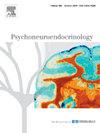Investigating the association between hair progesterone, anxiety, sleep quality, and other determinants in South African females
IF 3.6
2区 医学
Q2 ENDOCRINOLOGY & METABOLISM
引用次数: 0
Abstract
Background
Anxiety symptoms and poor sleep quality are common in women. The role of sex hormones, particularly progesterone, in anxiety and sleep quality in women is understudied. Measurement of hair progesterone concentrations (HPC) is a promising method to investigate the effects of progesterone on anxiety symptoms and sleep quality in women.
Objectives
We analysed sociodemographic, hair-related, and clinical factors associated with HPC and investigated the association between HPC and anxiety severity and sleep quality in a sample of 159 South African women (mean age: 46.5 years; range: 18–79 years).
Methods
Data were obtained from control participants from the SHARED ROOTS study. HPC were determined using an established liquid chromatography-tandem mass spectrometry (LC-MS/MS) method. Unadjusted and adjusted multiple linear regression models were used to investigate whether sleep quality, measured with the Pittsburgh Sleep Quality Index (PSQI), and anxiety, measured with the Spielberger State-Trait Anxiety Inventory (STAI), were associated with HPC. Significant sociodemographic, hair-related, and clinical factors were adjusted for.
Results
HPC was significantly associated with age, duration of sample storage, hormonal treatment, postmenopausal status, and the number of different types of trauma exposures in adjusted models. Neither anxiety severity nor sleep quality was significantly associated with HPC.
Conclusions
Certain demographic, hair related, and clinical factors were associated with HPC and need to be considered in future research using HPC. Although anxiety and sleep were not associated with HPC, greater trauma exposure was associated with higher HPC, suggesting an association between severe stress and hypothalamic-pituitary-gonadal (HPG) axis functioning.
调查南非女性毛发孕酮、焦虑、睡眠质量和其他决定因素之间的关联。
背景介绍焦虑症状和睡眠质量差在女性中很常见。性激素(尤其是孕酮)在女性焦虑和睡眠质量中的作用尚未得到充分研究。测量头发中的孕酮浓度(HPC)是研究孕酮对女性焦虑症状和睡眠质量影响的一种很有前景的方法:我们分析了与 HPC 相关的社会人口学因素、头发相关因素和临床因素,并在 159 名南非女性(平均年龄:46.5 岁;范围:18-79 岁)样本中调查了 HPC 与焦虑严重程度和睡眠质量之间的关联:方法:数据来源于 SHARED ROOTS 研究的对照参与者。采用成熟的液相色谱-串联质谱(LC-MS/MS)方法测定 HPC。使用未经调整和调整的多元线性回归模型来研究用匹兹堡睡眠质量指数(PSQI)测量的睡眠质量和用斯皮尔伯格状态-特质焦虑量表(STAI)测量的焦虑是否与 HPC 相关。对重要的社会人口、头发相关和临床因素进行了调整:结果:在调整后的模型中,HPC与年龄、样本保存时间、激素治疗、绝经后状态以及不同类型的创伤暴露次数有明显关系。焦虑严重程度和睡眠质量均与 HPC 无明显关联:结论:某些人口统计学因素、头发相关因素和临床因素与 HPC 相关,在未来使用 HPC 进行研究时需要加以考虑。虽然焦虑和睡眠与 HPC 无关,但更大的创伤暴露与更高的 HPC 相关,这表明严重压力与下丘脑-垂体-性腺轴(HPG)功能之间存在关联。
本文章由计算机程序翻译,如有差异,请以英文原文为准。
求助全文
约1分钟内获得全文
求助全文
来源期刊

Psychoneuroendocrinology
医学-精神病学
CiteScore
7.40
自引率
8.10%
发文量
268
审稿时长
66 days
期刊介绍:
Psychoneuroendocrinology publishes papers dealing with the interrelated disciplines of psychology, neurobiology, endocrinology, immunology, neurology, and psychiatry, with an emphasis on multidisciplinary studies aiming at integrating these disciplines in terms of either basic research or clinical implications. One of the main goals is to understand how a variety of psychobiological factors interact in the expression of the stress response as it relates to the development and/or maintenance of neuropsychiatric illnesses.
 求助内容:
求助内容: 应助结果提醒方式:
应助结果提醒方式:


